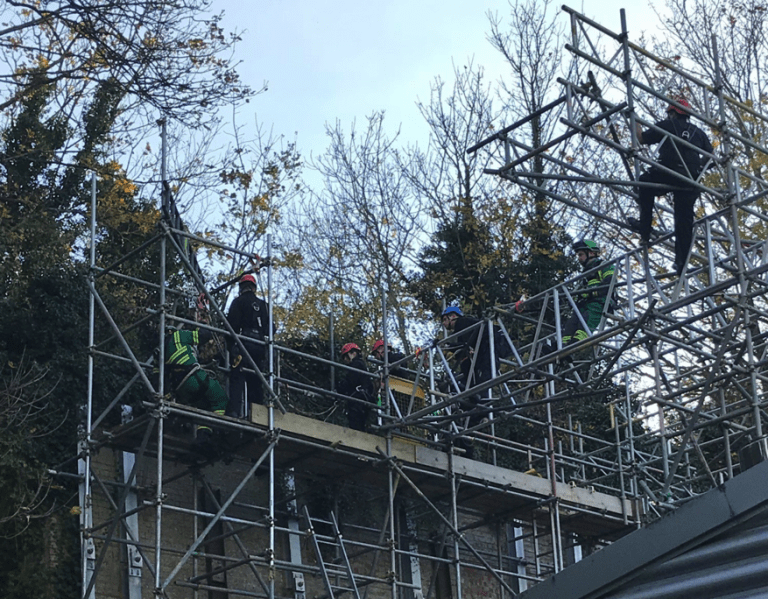Trade Body Warns Of Dodgy Contract Sourcing Scheme
The National Access and Scaffolding Confederation (NASC) has received reports of their full contracting members being allegedly scammed at great financial cost by a company calling themselves ‘BR Network.’
Using the name of ‘Project Hub’ on their correspondence, the firm has been offering a service on behalf of so-called main contractors aimed at sourcing reputable scaffolding companies for potential contracts.
TRADGuard provides protection on London’s ‘Can of Ham’
TRAD Safety System’s were proud to be involved in the erection of 70 St Mary Axe, City of London, where they supplied over 4,000 linear metres of their TRADGuard Temporary Mesh Edge Protection to the 90m high skyscraper, providing protection to the perimeter steel work.
Also nicknamed as the ‘Can of Ham’– due to its semi-elliptical design that resembles the tinned meat – the distinctive new 41,515 sq.m building will provide efficient, flexible and modern office space, and retail space at ground level.
The TRADGuard supplied by TRAD Safety System’s was an increased height system, providing 1.9m high mesh edge protection, and connected to the structure via welded sockets pre-fabricated to the perimeter beams. On the higher levels of this 24-storey office tower, the edge protection ‘raked’ backwards into the building to accommodate the curved glazing.
Oliver Gwinnell, National Sales Manager for TRAD Safety Systems commented, “This is the first time any such angled mesh edge protection system has been supplied in the UK. Our engineering team worked collaboratively on this bespoke and unique detail with engineers from our client Victor Buyck-Hollandia for two years prior to the job going live.”
 TRADGuard is a highly versatile system, with a range of attachments to suit a wide range of applications. The system boasts unrivalled strength, containment and flexibility, and is suitable for nearly all types of construction where temporary edge protection is required. To find out more, contact TRAD Safety Systems on 08450 50 70 50.
TRADGuard is a highly versatile system, with a range of attachments to suit a wide range of applications. The system boasts unrivalled strength, containment and flexibility, and is suitable for nearly all types of construction where temporary edge protection is required. To find out more, contact TRAD Safety Systems on 08450 50 70 50.
 TRAD Safety System’s is part of the TRAD Group, which also comprises of TRAD Scaffolding Contractors and TRAD Hire & Sales. TRAD Safety Systems are the UK’s market leader in the design, manufacture and supply of innovative fall safety solutions for the building, construction and maintenance industries. With six depots nationwide, TRAD Safety Systems can effectively service any project in the UK.
TRAD Safety System’s is part of the TRAD Group, which also comprises of TRAD Scaffolding Contractors and TRAD Hire & Sales. TRAD Safety Systems are the UK’s market leader in the design, manufacture and supply of innovative fall safety solutions for the building, construction and maintenance industries. With six depots nationwide, TRAD Safety Systems can effectively service any project in the UK.
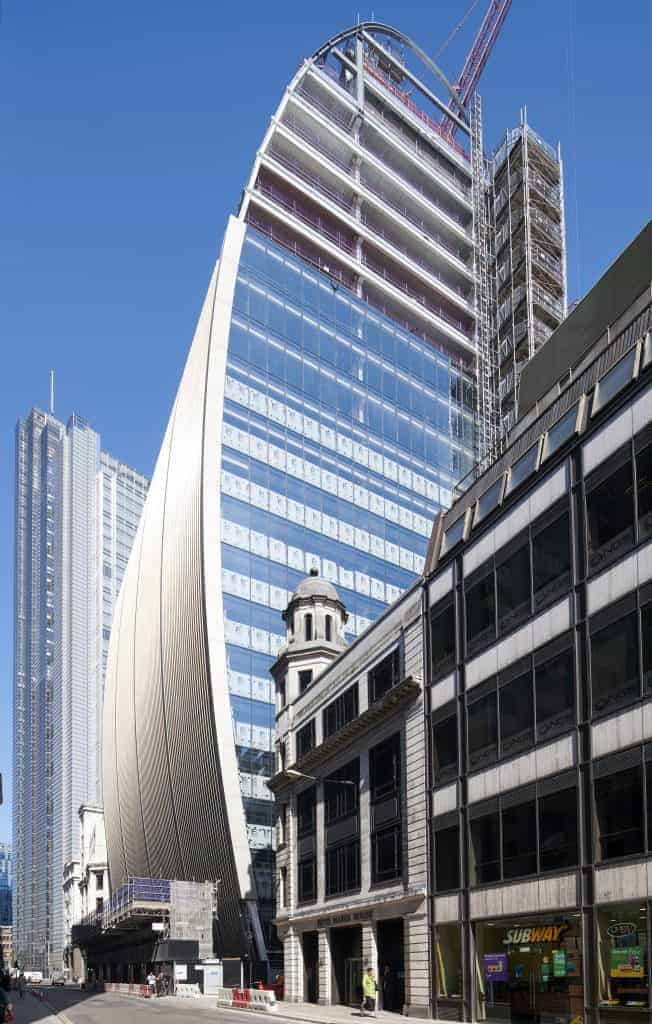 TRADGuard is a highly versatile system, with a range of attachments to suit a wide range of applications. The system boasts unrivalled strength, containment and flexibility, and is suitable for nearly all types of construction where temporary edge protection is required. To find out more, contact TRAD Safety Systems on 08450 50 70 50.
TRADGuard is a highly versatile system, with a range of attachments to suit a wide range of applications. The system boasts unrivalled strength, containment and flexibility, and is suitable for nearly all types of construction where temporary edge protection is required. To find out more, contact TRAD Safety Systems on 08450 50 70 50.
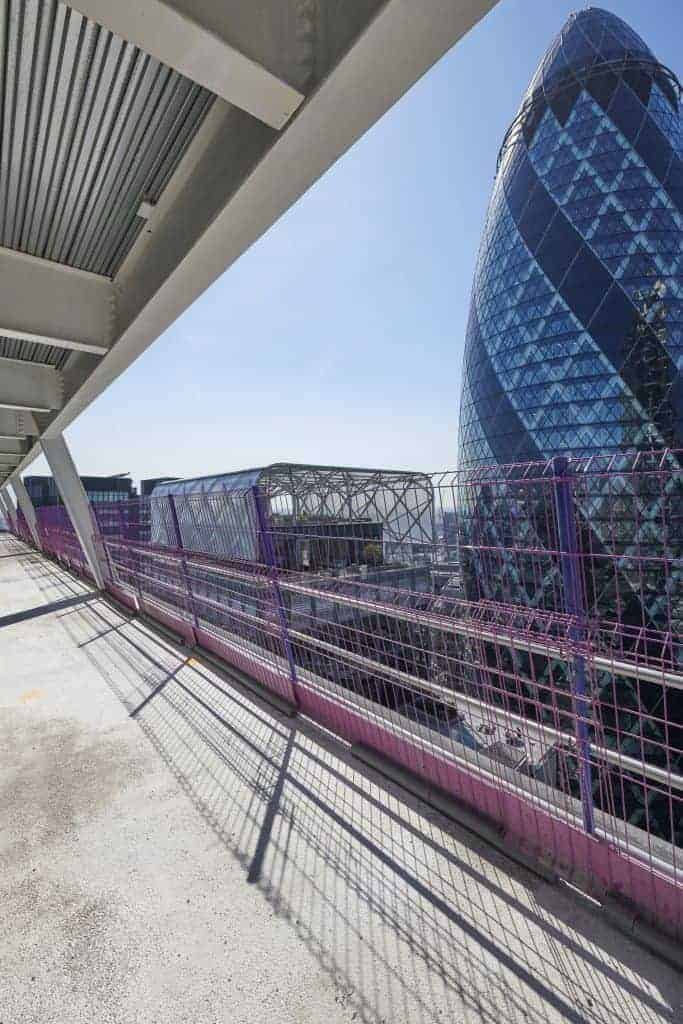 TRAD Safety System’s is part of the TRAD Group, which also comprises of TRAD Scaffolding Contractors and TRAD Hire & Sales. TRAD Safety Systems are the UK’s market leader in the design, manufacture and supply of innovative fall safety solutions for the building, construction and maintenance industries. With six depots nationwide, TRAD Safety Systems can effectively service any project in the UK.
TRAD Safety System’s is part of the TRAD Group, which also comprises of TRAD Scaffolding Contractors and TRAD Hire & Sales. TRAD Safety Systems are the UK’s market leader in the design, manufacture and supply of innovative fall safety solutions for the building, construction and maintenance industries. With six depots nationwide, TRAD Safety Systems can effectively service any project in the UK. 2018 NASC Awards: Winners Revealed
Industry leading firms and members of the scaffolding and access community came together in Edinburgh on Friday evening for the annual NASC 2018 Awards & Ball.
The sell-out glitzy event, held at the Sheraton Grand Hotel & Spa, saw over 400 attendees from some of the UK’s leading scaffolding firms converge to celebrate the very best in scaffolding. Champagne and canapés awaited guests on arrival to the black-tie event, followed by a fine-dining three-course meal and a wealth of top-class after-dinner entertainers. leading on to the main event hosted by acclaimed TV presenter and former international gymnast Gabby Logan.
The Awards
The recently expanded NASC Awards ceremony featured seven categories, including Project of the Year and Health & Safety – which were both split into Large and Small sub-categories – as well as the Apprentice of the Year and the Scaffolding Product Innovation award.Project of the Year – Turnover over £5 million
Sponsored by ScaffMag
- PHD Modular Access Services Ltd (Winner) – Project: Big Ben Conservation Project, London.
- GKR Ltd (Runner-up) – Project: Wimbledon Court One, London.
- TRAD Scaffolding Ltd (Highly Commended) – Project: Intu Watford Shopping Centre Roof.
- Millcroft Services plc – Project: Athlone House, Highgate.
Project of the Year – Turnover up to £5 million
Sponsored by Layher UK Ltd
- Coventry Scaffolding Ltd (Winner) – Project: The London Mastaba.
- LTC Group 87 (Runner-up) – Project: UK Hydrographic Office Taunton.
- Chris Sedgeman Scaffolding Ltd (Highly commended) – Project: Longrock Depot, Penzance.
- CCS Scaffolding Ltd – Project: Waterloo International Terminal Upgrade
NASC President’s Award
Sponsored by TRAD Safety Systems Ltd
- RPF Ltd (Winner)
- Chris Sedgeman Scaffolding Ltd (Runner-up)
- High Peak Scaffolding Ltd
- TRAD Group Ltd
Innovation Award
Sponsored by Prime Scaffold and Structural Designs Ltd
- GKR Ltd (Winner)
- PERI Ltd (Runner-up)
- KAEFER Ltd
- TRAD Safety Systems
Health and Safety Award – 67+ Employees
Sponsored by Simian Risk Group
- GKR Ltd (Winner)
- Connect Scaffolding Ltd (Runner-up)
- SCA Group Ltd
- TRAD Scaffolding Co Limited
Health and Safety Award – 1-66 Employees
Sponsored by Safety & Access Ltd
- Malvern Scaffolding Ltd (Winner)
- Complete Access Scaffolding Ltd (Runner-up)
- Allen & Foxworthy Ltd
- Focus MDC Ltd
Apprentice of the Year
Sponsored by TRAD Hire & Sales Ltd
- George Duke – Connect Scaffolding Ltd (Winner)
- Robert Grant – ASC Ltd (Runner-up)
- Jordan Edwards – TRAD Scaffolding Company Ltd
- Callum Ward – KAEFER Ltd
Charities Benefit
Despite the impressive line-up and prestigious awards ceremony, the highlight of the night was inarguably the generous attendees, who helped raise more than £50,000 for charity, which will be split between the Lighthouse Club and Demelza Hospice Care for Children. Robin James, NASC Managing Director, said: “It was a fantastic evening. The planned elements of the evening were incredibly well-received, from the keenly contested awards to the night’s entertainment. “What was more pleasing for me was the element outside of our control; the charity auction. The five lots drew bids far exceeding their reserve prices, and this total was boosted further by a number of members who donated significant sums of money on the night. “We could not possibly have expected to raise such a large amount for the two nominated charities and would like to thank the members for their generosity.” Bill Hill, CEO of the Lighthouse Club, said: “It was a magnificent event and I thoroughly enjoyed the evening. I cannot believe how generous the membership and their guests were in raising such an incredible amount on the evening. “100% of this donation will go towards supporting our Construction Industry Helpline and supporting our construction workforce and their families in crisis.” Ryan Campbell, CEO of Demelza Hospice Care for Children, added: “We were overwhelmed by the kindness of NASC members. To receive a donation of more than £25,000 was completely unexpected. “It is only through donations such as this that we are able us to continue to provide vital services and support to life-limited children and their families.”Scaffolding Firm Provides Lifesaving Services To HART
Cambridge & Hertfordshire based company Royston Scaffolding Ltd recently provided specialised scaffolding to the East of England Hazardous Area Response Team (HART).
The specialist ambulance service, that provides expert medical care in particularly difficult environments that includes safe rescue at height, confined spaces and urban search and rescue.
HART called upon Royston Scaffolding to erect a unique scaffolding construction to replicate a crane mast and various other structures to practice their response services on.
The specially designed scaffold structure erected, which replicated vertical ladders and a lift shaft, now enables the East of England HART crew to practice fall and arrest procedures as well as saving people from height and in confined spaces.
Elliott McGrath, Managing Director at Royston Scaffolding Ltd, said “We worked closely with HART to replicate the typical environments that they might encounter. While we’ve been part of many different scaffolding projects before, this was a particularly unique case, but one that we are really proud to have been part of.”Dunstable’s rope rescue team training with Hazardous Area Response Team (HART) at East of England Ambulance HQ, Melbourn. Great opportunity to train together & rescue someone that had fallen from height. Big thank you to @EEAST_HART for allowing us to use their training venue. pic.twitter.com/GkgN9DZIeJ
— Beds Fire and Rescue (@BedsFire) November 9, 2018
Winning Combination for TRAD Hire & Sales and Coventry Scaffolding
TRAD Hire & Sales has congratulated their client Coventry Scaffolding Co (London) Ltd on winning the NASC Scaffolding Project of the Year (Turnover up to £5million) Award, which was announced during the NASC Annual Ball and Awards in Edinburgh on 23rd November 2018.
Coventry Scaffolding won the coveted award for their work on the unique art installation, London Mastaba, on the Serpentine Lake in London’s Hyde Park.
The London Mastaba was created by world-renowned Bulgarian artist, Christo and his late wife, Jeanne Claude. A mastaba – meaning “eternal house” in Ancient Egyptian – is a type of ancient Egyptian tomb in the form of a flat-roofed, rectangular structure with inward sloping sides, constructed out of mud. The iconic London structure stood at 20m high, was formed of 7,506 barrels that were stacked horizontally, and floated on the Serpentine Lake between 12th June and 23rd September 2018.
Due to the uniqueness of this structure, the project was presented with a number of challenges, that TRAD Hire & Sales helped Coventry Scaffolding to overcome. Coventry Scaffolding decided early on in the design phase that system scaffolding would be the best option, and TRAD Hire & Sales’ exclusive Plettac Metrix System was the obvious solution due to it’s speed of erection, safety, adaptability and availability. The innovative system, with horizontal dimensions that are completely metric, allows both the tubular transoms and ledgers to be substituted by components of a smaller size, permitting the use of extra verticals within a bay length or width. This feature advances efficiency and vastly increases the ease by which adaptions can be made.
 A trial version was erected in Bulgaria at a third of the size of the eventual structure in London, so that the obstacle of erecting scaffolding on a floating platform could be tackled. The weight of the scaffolding meant the platform sagged, but this was overcome by implementing a steel grid from which the scaffolding could be erected.
Work then began in London on 23rd April 2018 with a team of over 100. Owing to fixed sizes of the barrels, as well as the 4x3x2 proportions of the structure, tolerances were down to the very last millimetre. The barrels also had to be installed after the scaffolding was erected, and the first line of barrels needed to be supported below the base line of the scaffold in order to achieve the perfect aesthetic for the artist – it was crucial the barrels looked like they were floating on the lake, so the scaffolding could not be visible.
A trial version was erected in Bulgaria at a third of the size of the eventual structure in London, so that the obstacle of erecting scaffolding on a floating platform could be tackled. The weight of the scaffolding meant the platform sagged, but this was overcome by implementing a steel grid from which the scaffolding could be erected.
Work then began in London on 23rd April 2018 with a team of over 100. Owing to fixed sizes of the barrels, as well as the 4x3x2 proportions of the structure, tolerances were down to the very last millimetre. The barrels also had to be installed after the scaffolding was erected, and the first line of barrels needed to be supported below the base line of the scaffold in order to achieve the perfect aesthetic for the artist – it was crucial the barrels looked like they were floating on the lake, so the scaffolding could not be visible.
 Plettac Metrix was the perfect partner to this complex project. The system’s simplicity, which is enhanced by its unique divisibility, allowed the demanding two month timeframe to be easily achieved. TRAD Hire & Sales were very proud to supply the scaffold on such a unique and impressive structure, and congratulate Coventry Scaffolding on their successful win at the NASC Annual Ball & Awards Ceremony.
Plettac Metrix® System Scaffold is exclusive to TRAD Hire & Sales and is offered on both a Hire and Sale basis. TRAD Hire & Sales offer an unrivalled commitment to service, including extensive User Guides, Nationwide Training, Engineering and Design Support, Estimating Software, and a full on-site support service – their UK-wide network of depots have the resources and capabilities to meet every demand.
Plettac Metrix was the perfect partner to this complex project. The system’s simplicity, which is enhanced by its unique divisibility, allowed the demanding two month timeframe to be easily achieved. TRAD Hire & Sales were very proud to supply the scaffold on such a unique and impressive structure, and congratulate Coventry Scaffolding on their successful win at the NASC Annual Ball & Awards Ceremony.
Plettac Metrix® System Scaffold is exclusive to TRAD Hire & Sales and is offered on both a Hire and Sale basis. TRAD Hire & Sales offer an unrivalled commitment to service, including extensive User Guides, Nationwide Training, Engineering and Design Support, Estimating Software, and a full on-site support service – their UK-wide network of depots have the resources and capabilities to meet every demand.
 A trial version was erected in Bulgaria at a third of the size of the eventual structure in London, so that the obstacle of erecting scaffolding on a floating platform could be tackled. The weight of the scaffolding meant the platform sagged, but this was overcome by implementing a steel grid from which the scaffolding could be erected.
Work then began in London on 23rd April 2018 with a team of over 100. Owing to fixed sizes of the barrels, as well as the 4x3x2 proportions of the structure, tolerances were down to the very last millimetre. The barrels also had to be installed after the scaffolding was erected, and the first line of barrels needed to be supported below the base line of the scaffold in order to achieve the perfect aesthetic for the artist – it was crucial the barrels looked like they were floating on the lake, so the scaffolding could not be visible.
A trial version was erected in Bulgaria at a third of the size of the eventual structure in London, so that the obstacle of erecting scaffolding on a floating platform could be tackled. The weight of the scaffolding meant the platform sagged, but this was overcome by implementing a steel grid from which the scaffolding could be erected.
Work then began in London on 23rd April 2018 with a team of over 100. Owing to fixed sizes of the barrels, as well as the 4x3x2 proportions of the structure, tolerances were down to the very last millimetre. The barrels also had to be installed after the scaffolding was erected, and the first line of barrels needed to be supported below the base line of the scaffold in order to achieve the perfect aesthetic for the artist – it was crucial the barrels looked like they were floating on the lake, so the scaffolding could not be visible.
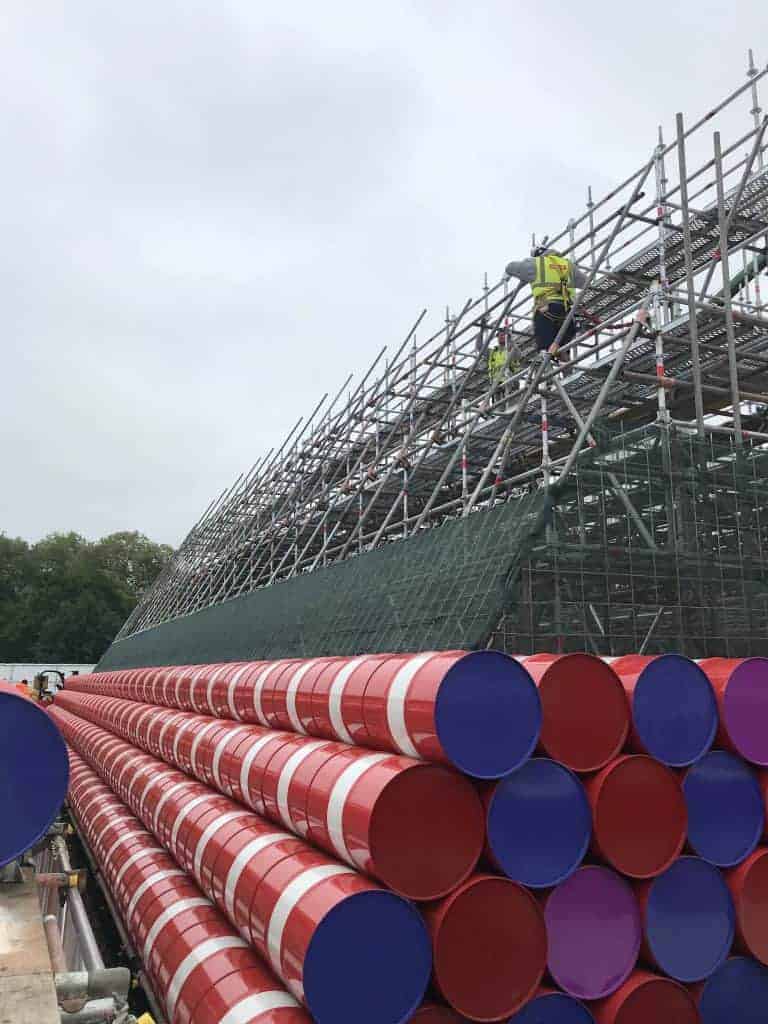 Plettac Metrix was the perfect partner to this complex project. The system’s simplicity, which is enhanced by its unique divisibility, allowed the demanding two month timeframe to be easily achieved. TRAD Hire & Sales were very proud to supply the scaffold on such a unique and impressive structure, and congratulate Coventry Scaffolding on their successful win at the NASC Annual Ball & Awards Ceremony.
Plettac Metrix® System Scaffold is exclusive to TRAD Hire & Sales and is offered on both a Hire and Sale basis. TRAD Hire & Sales offer an unrivalled commitment to service, including extensive User Guides, Nationwide Training, Engineering and Design Support, Estimating Software, and a full on-site support service – their UK-wide network of depots have the resources and capabilities to meet every demand.
Plettac Metrix was the perfect partner to this complex project. The system’s simplicity, which is enhanced by its unique divisibility, allowed the demanding two month timeframe to be easily achieved. TRAD Hire & Sales were very proud to supply the scaffold on such a unique and impressive structure, and congratulate Coventry Scaffolding on their successful win at the NASC Annual Ball & Awards Ceremony.
Plettac Metrix® System Scaffold is exclusive to TRAD Hire & Sales and is offered on both a Hire and Sale basis. TRAD Hire & Sales offer an unrivalled commitment to service, including extensive User Guides, Nationwide Training, Engineering and Design Support, Estimating Software, and a full on-site support service – their UK-wide network of depots have the resources and capabilities to meet every demand. NASC Raises The Bar At 2018 AGM
The National Access and Scaffolding Confederation (NASC) has made significant changes in terms of outputs and activities undertaken in 2018, according to Robin James, Managing Director.
Speaking at the NASC’s AGM in Edinburgh on Friday 23 November, Confederation members, guests and members of the construction press that included ScaffMag heard how the NASC had raised the bar in a number of areas during 2018. Mr James also mentioned and paid tribute to the hard work of NASC members, its Committees, Officers & Directors and President for playing their part in driving the standards synonymous with the NASC even higher. “Since the last NASC AGM in London, in November 2017, we’ve come a long way,” he said. “Under the Presidency of Des Moore, TRAD Group CEO, there has been a ‘step change’ in the organisation. “At the NASC AGM twelve months ago Des set out his presidential objectives. Great strides have already been made. This includes greater numbers of NASC presentations and events, greater emphasis on promoting mentoring, diversity and wellbeing with the membership and greater involvement of women on NASC committees and working groups. “Speaking of which, the NASC standing committees continue to progress significant bodies of work, and I’d like to thank them for their efforts. “2018 has been a great year for the NASC. We believe we have plans in place to ensure 2019 is even better and would urge greater involvement and engagement by members at NASC regional meetings and beyond.” Other speakers at the NASC AGM, held at the Sheraton Grand Hotel & Spa, included Des Moore, NASC President and TRAD Group CEO and Gerry Cooper, NASC President 2010-2011, who gave an overview of entries shortlisted for the NASC 2018 Awards, which were due to be held at the same venue later that night.
TV presenter and former international gymnast Gabby Logan gave the keynote speech.
Other speakers at the NASC AGM, held at the Sheraton Grand Hotel & Spa, included Des Moore, NASC President and TRAD Group CEO and Gerry Cooper, NASC President 2010-2011, who gave an overview of entries shortlisted for the NASC 2018 Awards, which were due to be held at the same venue later that night.
TV presenter and former international gymnast Gabby Logan gave the keynote speech.
 Des Moore said: “The AGM was incredibly well attended by our members, which demonstrates how much they value membership.
“It was a great opportunity to take stock of what the NASC has achieved in the past year and from a personal point of view, how much progress we have made against the four objectives I announced at the beginning of my tenure as President.
“I am immensely proud of our successes in 2018 and believe we’re on the right track to delivering even greater results in the year ahead.”
Des Moore said: “The AGM was incredibly well attended by our members, which demonstrates how much they value membership.
“It was a great opportunity to take stock of what the NASC has achieved in the past year and from a personal point of view, how much progress we have made against the four objectives I announced at the beginning of my tenure as President.
“I am immensely proud of our successes in 2018 and believe we’re on the right track to delivering even greater results in the year ahead.” TRAD Hire & Sales Release New ALTRIX Temporary Roof System User Guide
 Following on from the introduction of the new User Guide and Component Capacity Manual for their revolutionary PLETTAC METRIX® System Scaffold, TRAD Hire & Sales are proud to announce the launch of the new User Guide for their ALTRIX® Temporary Roof System.
ALTRIX® is an all-aluminium modular temporary roofing and weather protection system, which utilises the slide sheet keder model. Using the proven sliding button system to retain the sheet tracking, this allows the roof sheets to be installed in complete safety from the supporting structure below.
Although ALTRIX® is designed to work particularly efficiently with PLETTAC METRIX® System Scaffold, it is not limited to this application. ALTRIX® can be used in conjunction with almost any scaffold type – systems or traditional tube & fittings.
Following on from the introduction of the new User Guide and Component Capacity Manual for their revolutionary PLETTAC METRIX® System Scaffold, TRAD Hire & Sales are proud to announce the launch of the new User Guide for their ALTRIX® Temporary Roof System.
ALTRIX® is an all-aluminium modular temporary roofing and weather protection system, which utilises the slide sheet keder model. Using the proven sliding button system to retain the sheet tracking, this allows the roof sheets to be installed in complete safety from the supporting structure below.
Although ALTRIX® is designed to work particularly efficiently with PLETTAC METRIX® System Scaffold, it is not limited to this application. ALTRIX® can be used in conjunction with almost any scaffold type – systems or traditional tube & fittings.
 ALTRIX® uses a heavy-duty 790mm deep structural beam ideal for demanding applications. The chords and vertical posts of the beams are manufactured from 48.3mm diameter alloy tube and, as they do not require special fittings, the beams are suitable for use in many normal scaffold applications, such as bridge sections.
ALTRIX® is more than just a roof, the 3.0m, 2.5m, 2.0m and 1.5m bay sizes, along with 2.0m brace frame centres, means that PLETTAC METRIX® steel decking can integrate seamlessly within an ALTRIX® structure.
This setup is ideal for creating large flushed deck birdcages and gantries while also allowing for temporary walkways to be created from eaves to ridge, aiding the safe erection and dismantling processes of a roof structure.
ALTRIX® is a complete solution, designed for practical application. Not only is ALTRIX® a temporary roof used by scaffolders, it is a scaffolders’ temporary roof.
ALTRIX® Temporary Roof System is exclusive to TRAD Hire & Sales, and is offered on both a Hire and Sale basis. They offer an unrivalled commitment to service, including extensive User Guides, Nationwide Training, Engineering and Design Support, Estimating Software, and a full on-site support service – their UK-wide network of depots have the resources and capabilities to meet every demand.
ALTRIX® uses a heavy-duty 790mm deep structural beam ideal for demanding applications. The chords and vertical posts of the beams are manufactured from 48.3mm diameter alloy tube and, as they do not require special fittings, the beams are suitable for use in many normal scaffold applications, such as bridge sections.
ALTRIX® is more than just a roof, the 3.0m, 2.5m, 2.0m and 1.5m bay sizes, along with 2.0m brace frame centres, means that PLETTAC METRIX® steel decking can integrate seamlessly within an ALTRIX® structure.
This setup is ideal for creating large flushed deck birdcages and gantries while also allowing for temporary walkways to be created from eaves to ridge, aiding the safe erection and dismantling processes of a roof structure.
ALTRIX® is a complete solution, designed for practical application. Not only is ALTRIX® a temporary roof used by scaffolders, it is a scaffolders’ temporary roof.
ALTRIX® Temporary Roof System is exclusive to TRAD Hire & Sales, and is offered on both a Hire and Sale basis. They offer an unrivalled commitment to service, including extensive User Guides, Nationwide Training, Engineering and Design Support, Estimating Software, and a full on-site support service – their UK-wide network of depots have the resources and capabilities to meet every demand.

Exclusive: Ambitious Partnership Replaces CITB
A new dynamic partnership between Waltham Forest Council and Dudley College of Technology will replace the Construction Industry Training Board (CITB) in National Construction College.
This exciting Leyton combination also sees scaffolding training provider Simian teaming up with both the Dudley establishment and the council, to meet the demands of traditional trades. It will, of course, provide the high-quality tuition required to meet the needs of an evolving industry. The Council will lead on the digitisation of the Construction sector, as Dudley College delivers virtual reality and modern methods of construction. As the UK’s largest private provider of world-class training, Simian will ensure the East London centre continues to assist the industry to fill crucial skills gaps in the scaffolding sector. At the same time, it will innovatively develop tailor-made solutions for the industry as a whole. Dudley College of Technology is one of 20 Outstanding FE Colleges in the UK, considered a national leader of training in modern methods of construction delivery. They are one of 16 institutions nationwide to be selected by the Department of Education, to develop a stage two proposal to create one of their flagship Institutes of Technology with a construction focus. Waltham Forest is one of the NCC training sites, leased by CITB from the Council, to run construction skills training courses in the area. As part of CITB’s programme of reform, Vision 2020, CITB gave notice on the lease to end its contract and exit the site from July 2018. This was delivered on the understanding both parties would work together on the shared goal to find a new tenant-centre manager, to continue offering high-quality construction skills training. Simon Hughes, Simian’s Managing Director, said: “We’re delighted to be involved in the delivery of specialist scaffolding training in partnership with Dudley College, an organisation held in very high regard in the education world. It is our intention to place significant emphasis on the delivery of Scaffolding Apprenticeships at the Waltham Forest site, and to expand the existing training portfolio to include all CISRS scaffolding courses. We are confident this will play a significant part in addressing the construction industry skills shortage and meeting the Mayor of London’s objectives.”
Cllr Simon Miller, Waltham Forest’s Cabinet Member for Economic Growth and High Streets added: “We were delighted to welcome Dudley College of Technology to Waltham Forest. They presented an exciting programme of activity and transformation to current Centre activity and demonstrated a history of high-quality and innovative training delivery.
“As CITB withdraw from the National Construction Centre model it presents all parties to use this opportunity to create best practice and ensure we continue offering high-quality construction skills training that benefits not just our residents and the local economy, but the industry as a whole.
“It is our ambition for the newly launched Centre to deliver a wide range of training, which provides a complete overview of the Built Environment and Construction process and considers the changing future of work.
“With demand for quality homes across the borough and London increasing, our partnership with Dudley College will deliver a programme of training that tackles current skills shortages in the borough and across London, while providing insight and qualifications on the latest methods of delivery.”
Simon Hughes, Simian’s Managing Director, said: “We’re delighted to be involved in the delivery of specialist scaffolding training in partnership with Dudley College, an organisation held in very high regard in the education world. It is our intention to place significant emphasis on the delivery of Scaffolding Apprenticeships at the Waltham Forest site, and to expand the existing training portfolio to include all CISRS scaffolding courses. We are confident this will play a significant part in addressing the construction industry skills shortage and meeting the Mayor of London’s objectives.”
Cllr Simon Miller, Waltham Forest’s Cabinet Member for Economic Growth and High Streets added: “We were delighted to welcome Dudley College of Technology to Waltham Forest. They presented an exciting programme of activity and transformation to current Centre activity and demonstrated a history of high-quality and innovative training delivery.
“As CITB withdraw from the National Construction Centre model it presents all parties to use this opportunity to create best practice and ensure we continue offering high-quality construction skills training that benefits not just our residents and the local economy, but the industry as a whole.
“It is our ambition for the newly launched Centre to deliver a wide range of training, which provides a complete overview of the Built Environment and Construction process and considers the changing future of work.
“With demand for quality homes across the borough and London increasing, our partnership with Dudley College will deliver a programme of training that tackles current skills shortages in the borough and across London, while providing insight and qualifications on the latest methods of delivery.”
 The Centre’s proposed programme of activity aligns with the Mayor’s agenda, in identifying the need for a programme of activity which closes the gap between their ambitious housing targets, and the need for more skilled construction workers in London. The London Mayor’s Construction Academy (MCA) Scheme, aims to fulfill the Mayor’s pledge.
The Council, in partnership with Transport for London and a number of supporting partners, has submitted a bid to the GLA for Hub status to act as a coordinating function for the construction industry in the capital. This will strengthen the relationships, and improve coordination, between construction skills training providers and construction sector employers across the city.
Deputy Mayor for Planning, Regeneration and Skills, Jules Pipe, explained: “This new partnership will benefit learners from across East London. By promoting the use of virtual reality training courses, digital technology and modern methods of construction, the new centre will help realise the Mayor’s ambition to equip Londoners with the up-to-date skills employers need, and create the workforce capable of delivering more homes in the future.”
The Centre Management partnership already comes with MCA Kitemark status, enabling the Council and Dudley College of Technology to work collaboratively with the GLA on their construction training agenda.
The Centre’s proposed programme of activity aligns with the Mayor’s agenda, in identifying the need for a programme of activity which closes the gap between their ambitious housing targets, and the need for more skilled construction workers in London. The London Mayor’s Construction Academy (MCA) Scheme, aims to fulfill the Mayor’s pledge.
The Council, in partnership with Transport for London and a number of supporting partners, has submitted a bid to the GLA for Hub status to act as a coordinating function for the construction industry in the capital. This will strengthen the relationships, and improve coordination, between construction skills training providers and construction sector employers across the city.
Deputy Mayor for Planning, Regeneration and Skills, Jules Pipe, explained: “This new partnership will benefit learners from across East London. By promoting the use of virtual reality training courses, digital technology and modern methods of construction, the new centre will help realise the Mayor’s ambition to equip Londoners with the up-to-date skills employers need, and create the workforce capable of delivering more homes in the future.”
The Centre Management partnership already comes with MCA Kitemark status, enabling the Council and Dudley College of Technology to work collaboratively with the GLA on their construction training agenda.
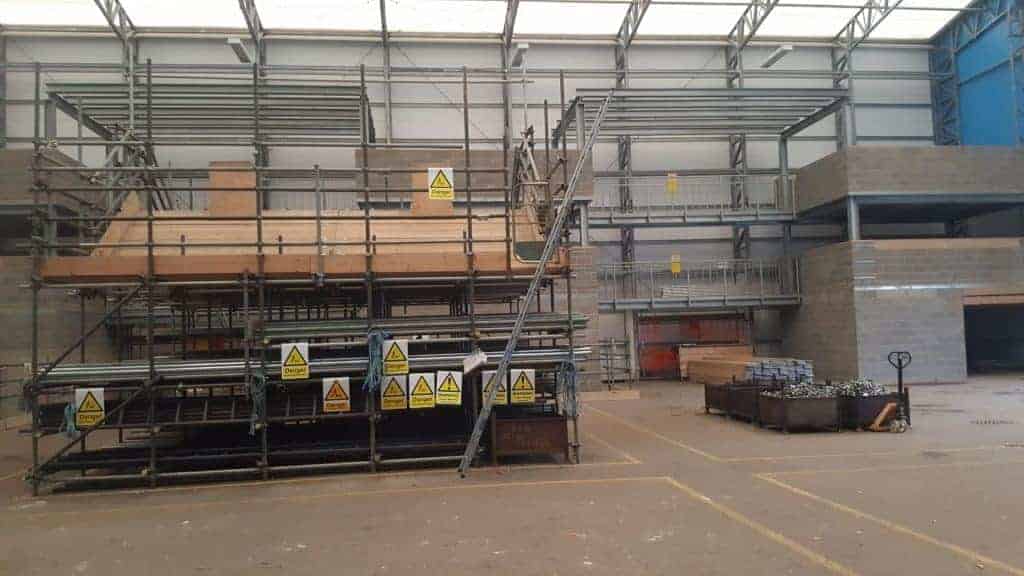 Graham McPhail, CITB Head of Education & Training, summed up the plans by saying: “CITB is committed to supporting a robust, high-quality skills and training market.
“By stepping away from direct delivery, we remove any conflict of interest. This enables us to focus on building the right relationships with providers to secure the kind of provision British construction needs.”
The partnership will commence after the Construction Industry Training Board (CITB) exit the Centre in January 2019.
Graham McPhail, CITB Head of Education & Training, summed up the plans by saying: “CITB is committed to supporting a robust, high-quality skills and training market.
“By stepping away from direct delivery, we remove any conflict of interest. This enables us to focus on building the right relationships with providers to secure the kind of provision British construction needs.”
The partnership will commence after the Construction Industry Training Board (CITB) exit the Centre in January 2019. Rose Scaffolding Powering The North West
Rose Scaffolding of Oldham has received a £250K loan in connection with the Northern Powerhouse Investment Fund to help further boost the North West economy.
As a young company trading since September, the financial boost has come from NPIF – FW Capital Debt Finance, managed by FW Capital and linked to the scheme charged with bolstering business and infrastructure in the region. The firm was set up by brothers James and Charles Brierley and Chris Howson in April last year to provide scaffolding for major construction projects in the area. In a few short months, the enterprise has contracts amounting to £3m boasting well-known names including Redrow, Bellway Homes and McCarthy and Stone. The money will be utilised to invest in cutting-edge kit while helping to create a number of new jobs including apprenticeships. Director James Brierley said: “Despite our success, there was no real appetite from high street banks to provide investment. James Scott Accountants made the initial introduction to Paul Mak of Pomegranate Commercial Finance, who in turn referred the deal to Adam Husband of FW Capital. “The funding has been used to buy high-quality materials from our German suppliers and bring in new staff including apprentices. The construction industry has an aging workforce and we want to address this by investing in training through quality apprenticeships to create opportunities for young people. “We have 25 full time and aim to have 40 by the end of next year including around six more apprentices. “In our plan, we’d forecasted to double our turnover but we are on target to treble it.” There’s little doubt the sizeable loan is a confident and adventurous move brought about by both the changing needs of the industry and the plans of an impressive new enterprise. “A key factor in our decision was the strength of the management team who had invested a lot of their own cash initially to get the business off the ground, demonstrating commitment and belief in what they were doing,” added FW Capital investment executive Adam Husband. Their strong track record in the sector was also crucial, having worked for a major scaffolding business prior to starting Rose Scaffolding. They have secured a huge amount of business in a short space of time and are working with key players in the construction industry. Rose Scaffolding is a really fantastic business and one that we are delighted to have supported.” As a new company with an experienced team. Rose System Scaffolding has invested heavily in Layher All-Round scaffolding and is working closely with key stakeholders including Strikesoft, Simian Risk and Layher to provide a first class service at competitive rates. Sue Barnard, Senior Manager at British Business Bank, said: “The North West continues to be a fast-growing market for construction. Rose Scaffolding is a relatively young company but it has managed to expand its client base and have influence over a number of major projects in the region. “The investment will positively impact the firm’s future growth ambitions, in the form of new specialised equipment, the creation of skilled jobs and vocational training for school leavers. It is these individual components that will boost the North West’s economic prosperity in the future and we look forward to seeing their development.Scandal Of Toilets In The UK Workplace
Workers union ‘UNITE’ are demanding employers ensure their staff have toilet dignity in the workplace. It may seem a basic right to many, but thousands of workers from a range of industries are still not being provided with decent toilet facilities or provision in the 21st century. Adding to this is the fact employer restrictions are also making life a misery for people working long shifts.



